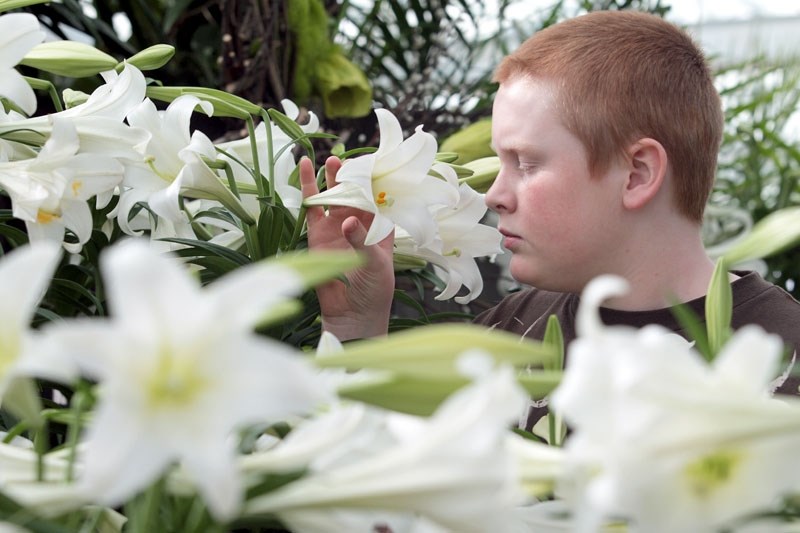The stunning, highly-perfumed Easter lily is a mainstay of the spring holiday season. In the next week an estimated 12 million Easter lilies will be sold across North America. The pure white flowers have a mythical history that goes back beyond the beginning of Christianity.
The ancient Greeks believed their god Juno was nursing her son Hercules when drops of milk fell to Earth and became white lilies. Christian tradition says that as Christ walked through the Garden of Gethsemane, drops of his sweat fell to the ground and became lilies.
The Virgin Mary is also associated with lilies and she is shown in some medieval paintings receiving pure white lilies from the angel Gabriel. In addition, the flowers are said to have grown at the mouth of the Virgin Mary’s own tomb. Eve is also remembered with lilies. When she left the Garden of Eden, Eve wept at her loss and her teardrops became lilies.
All these legends speak to the pure beauty of Lilium longiflorum, but strangely, the lily we have come to think of as an Easter lily is not a native of the Middle East, but instead has its roots in Japan.
Easter lilies were brought to England from Japan in the late 1700s. For most of the next century the British sold the world its Easter lilies from farms in Bermuda. In 1898 a virus attacked the Bermuda lily plants and production was moved to Japan.
The story diverges slightly at this point, because in 1919, an American soldier named Louis Houghton brought a suitcase full of lily bulbs home to Oregon. He gave the bulbs to farming friends, but the plants were not widely grown for resale in the United States until after the bombing of Pearl Harbor.
Soon after war was declared on Japan, a kind of frenzy took over the farmers on the Oregon coast. The lilies were called “white gold” and in the next few years some 1,200 farmers tried growing them. The number of speculators soon dwindled however, because growing Easter lilies is very labour intensive.
Just 10 Easter-lily-growing farmers remain on a 12-mile spit of land between the redwood trees and the California-Oregon coast. The region is now known as the Easter-lily capital of the world.
The three most common Easter lily cultivars are Nellie Whites, Ace or Snow Whites. It takes three years for the bulbs to grow big enough to produce a marketable flower. If they do start to bloom before they are three years old, the flower buds are picked off.
In each of those three growing years the bulbs must be dug up, searched for bulblets, which could produce new plants, and then replanted. The California Farm Bureau website estimates the bulbs are handled some 40 times before they finally reach the point of sale at Easter time.
Jim Hole of the Enjoy Centre said these lilies are the most difficult-to-manage crop that he has in his greenhouse because the date for Easter varies every year between March 24 and April 24. The flowers must be timed to open precisely two days before Easter. Just one day later and the wholesalers might as well turn their remaining lilies to compost, because they are no longer salable. In contrast, the poinsettia selling period is four to six weeks long.
“We have to keep the lilies cool, then warm them up, and cover them and do a whole range of activities to get them opening exactly on the weekend of Easter. And every year, the timing is different,” Hole said.
Easter lilies are not hardy here and getting them to flower again is a tricky business.
“This winter might have been the exception because we had so much snow. If you had tried to over-winter them this year, you might have had success with the snow cover, but it’s a lot of work,” Hole said.
One way to get an Easter lily to stay in bloom longer is to remove the stamens and pistils. Removing the orange pollen-laden stamens also helps the flowers to stay pure white.
Those sexy looking stamens and pistils were apparently of some concern in Victorian times too. The Victorians are said to have removed the stamens and pistils so they wouldn’t be concerned with sexuality issues or with impure thoughts when they attended their Easter morning church services.
Finally, Easter lilies are not considered edible and they can be extremely toxic to cats. Don’t let your cat chew the leaves, or it could suffer from kidney failure.
Related Story
To learn about lily varieties you can grow yourself, see today's At Home story.




